 Petzlover
Petzlover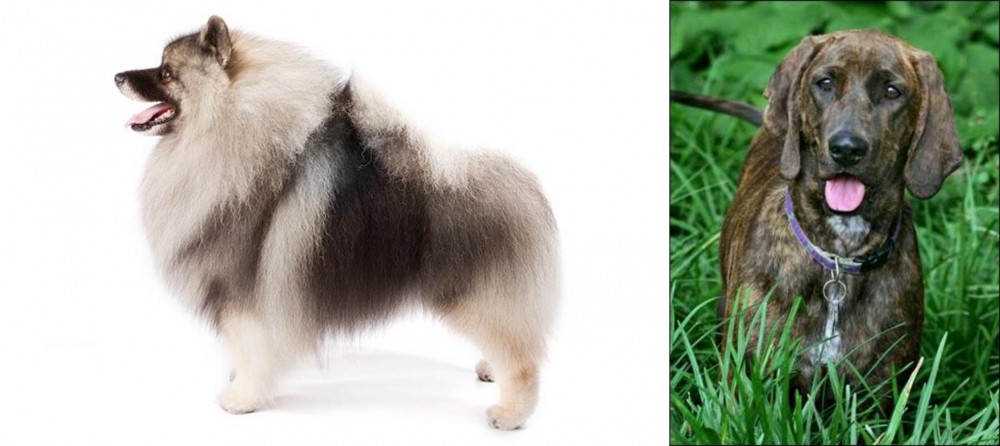 Keeshond is originated from Netherlands but Plott Hound is originated from Germany. Keeshond may grow 23 cm / 9 inches shorter than Plott Hound. Keeshond may weigh 9 kg / 19 pounds lesser than Plott Hound. Both Keeshond and Plott Hound has same life span. Both Keeshond and Plott Hound has almost same litter size. Keeshond requires Moderate Maintenance. But Plott Hound requires Low Maintenance
Keeshond is originated from Netherlands but Plott Hound is originated from Germany. Keeshond may grow 23 cm / 9 inches shorter than Plott Hound. Keeshond may weigh 9 kg / 19 pounds lesser than Plott Hound. Both Keeshond and Plott Hound has same life span. Both Keeshond and Plott Hound has almost same litter size. Keeshond requires Moderate Maintenance. But Plott Hound requires Low Maintenance
 Keeshond is the term used for German Spitzes and although many American references have it that the Keeshond originated in the Netherlands, some say the dog originated in Germany and is a member of the German Spitz family.
Keeshond is the term used for German Spitzes and although many American references have it that the Keeshond originated in the Netherlands, some say the dog originated in Germany and is a member of the German Spitz family.
The Club for German Spitzes was founded in 1899. The Nederlandse Keeshond Club was formed in 1924. The Keeshond is also referred to as ‘The Smiling Dutchman’.
It was in the 17th and 18th centuries that the Keeshond was used greatly as a watchdog, appearing in England in the late 1800s, but after the turn of the 20th century, Mrs. Wingfield Digby of Dorset, England and Mrs. Alice Gatacre, a Dutch breed authority, living in England, stirred interest in the breed with their kennels.
An English breed Club was formed in 1926, and the first Keeshond was registered with The American Kennel Club in 1930.
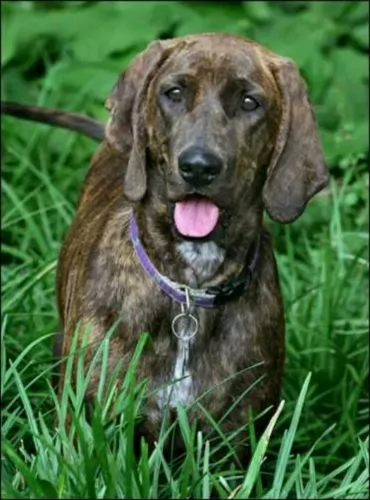 The Plott Hound is a scent hound who has always been used for for hunting bears. The dog may well be the state dog of North Carolina, but it isn’t well known.
The Plott Hound is a scent hound who has always been used for for hunting bears. The dog may well be the state dog of North Carolina, but it isn’t well known.
The Plott Hound is an old dog breed descending from several Hanoverian Schweisshunds which were brought to North Carolina way back in 1750. They were brought by a German immigrant, Johannes George Plott, and that is why it is believed that the dog hails from Germany.
It is believed that in the early 1900s the dog was mated with black-and-tan hounds, giving the canine additional scenting skills as well as its black-saddled brindle pattern. The dog breed has since been registered by the United Kennel Club and is also registered by the American Kennel Club.
 The Keeshond is a medium-sized dog and a member of the Spitz group of dogs. He stands at 43 – 48cm in height and weighs 14 – 18kg.
The Keeshond is a medium-sized dog and a member of the Spitz group of dogs. He stands at 43 – 48cm in height and weighs 14 – 18kg.
He has a 2-layered, dense coat which is fairly long, straight and coarse and colors are grey, silver, black and cream. His undercoat is a very light cream color. He has erect ears, a fairly shop muzzle and a feathery, plumed tail which curves over his back.
The hair on his legs is fairly short accompanied with some feathering. A typical marking-feature of the Keeshond is the dark line which runs from the outer corner of each eye to the lower corner of each ear. It's what gives the dog his well known keeshond expression. The eyes of the dog are dark brown.
The Keeshond, just like other Spitz dogs, are playful, affectionate, friendly and eager to please. He is intelligent too and will respond well to training and socialization.
He makes a wonderful family pet as he is friendly and playful with children, loving all their games. He gets on well with other pets too. He is a social dog, thriving on being with his human family, wanting to participate in all family activities.
They are sensitive, loving pets and become very attached to their owners. They have even been used as comfort dogs in rescue situations, as they bond so well with people.
He makes a good watchdog too with his loud bark which he uses to deter intruders. He may well be a good watch- and guard dog but he isn't an aggressive dog.
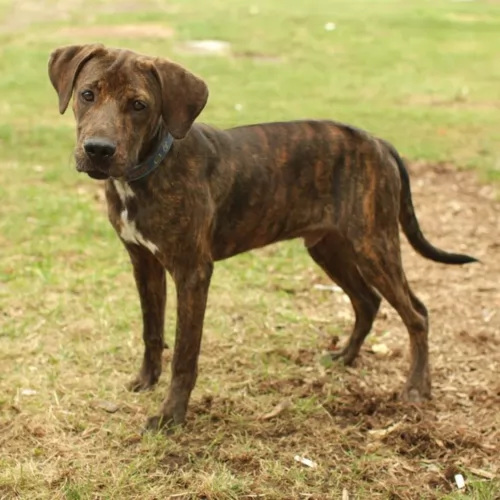 The Plott Hound is a large dog standing between 50 and 71cm in height, both male and female, and weighing in at between 18 to 27kg.
The Plott Hound is a large dog standing between 50 and 71cm in height, both male and female, and weighing in at between 18 to 27kg.
The dog’s coat is available in a number of brindle shades such as red-, blue, tan-, brown and black brindle. The ears of the dog are long and floppy and the tail is also long and held up or down, depending on whether the dog is quiet or excited. He is active and would not be recommended for a small homes in the city.
Bold, alert and intelligent, the Plott Hound is a confident, courageous and loyal pet, being somewhat aloof around strangers.
Typical of any hounds, he is a strong willed, independent dog, and this is why he will need training and socialization. These make him obedient so that he can respond to simple commands such as sit, lie down, come and stay. This makes him a pleasure to have around wherever you go with him. He is also protective, making him an excellent watchdog.
 The Keeshond, with his thick double coat, loves to be outdoors in cool weather. He won't be there too long however, because he will be missing his human family. He is such a social dog, craving human company and therefore isn't a dog to be put out in the backyard and left day after day.
The Keeshond, with his thick double coat, loves to be outdoors in cool weather. He won't be there too long however, because he will be missing his human family. He is such a social dog, craving human company and therefore isn't a dog to be put out in the backyard and left day after day.
He loves games and being totally involved with his human family. Look after your Keeshond well – he is a companion dog - and you will find him to be a most exceptional friend of yours.
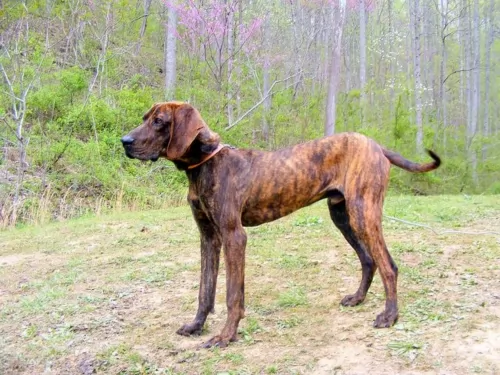 The Plott is a bold, aggressive type of dog, but he is also loving, loyal and intelligent.
The Plott is a bold, aggressive type of dog, but he is also loving, loyal and intelligent.
If you want him as a pet and companion, another bonus part is that his smooth, short coat makes him a low maintenance breed. He’s good looking too, and with training and socialization he’s going to make a great family friend, guardian and pet.
 With good food, fresh water, exercise and lots of interaction with your Keeshond, he can reach 12 to 14 years of age.
With good food, fresh water, exercise and lots of interaction with your Keeshond, he can reach 12 to 14 years of age.
No matter how healthy your dog is, he can still get ill, but the chances are less likely when he is feed nutritionally. Nonetheless look out for hip dysplasia, bloat, ear infections, skin rashes and eye diseases.
This is a problem in the lens of the eye. Your dog has a cloudy look to the eye. A cataract can occur when the cells are damaged. A disease such as diabetes can also cause a cataract and high blood sugar levels can change the metabolism of the cells in the lens.
The lens should be crystal clear, but with a cataract, the vision of the dog is obscured. It can cause blindness. Thankfully, cataracts aren't painful and most times dogs with cataracts can still see. There is the option of surgery to remove them too.
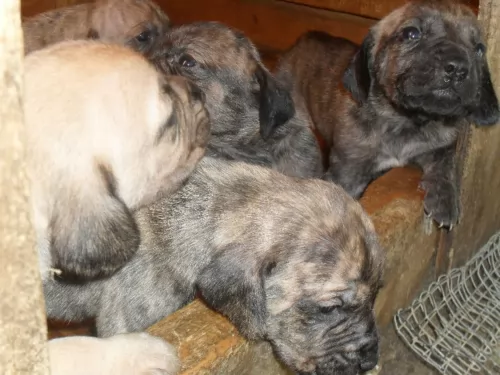 Your Plott Hound is a healthy dog breed and can live to be anything from 12 to 14 years of age. Just like with any other dog breed, they are prone to certain health conditions. It is however, highly unlikely that he will get any of the diseases, but it is good to be aware of some of them -
Your Plott Hound is a healthy dog breed and can live to be anything from 12 to 14 years of age. Just like with any other dog breed, they are prone to certain health conditions. It is however, highly unlikely that he will get any of the diseases, but it is good to be aware of some of them -
There are many forms of cancer and some of the symptoms of the disease include lumps, sores that won’t heal, difficulty with breathing, lack of energy and black stools. Cancer is of course life threatening and treatments will include the likes of chemotherapy, radiation and even surgery.
This is also a deadly disease where parasites infect a dog’s heart and arteries. With a mosquito bite, dogs are exposed to larvae, and if left unchecked, the larva can develop into large worms. Your dog will be coughing, be lethargic and in a run down state. This disease certainly requires veterinary intervention.
There are so many things that can cause your dog to vomit and also have diarrhea. Eating the wrong foods, having an infection such as parvo for instance can cause a dog to vomit. An isolated case of vomiting needn’t be cause for alarm, but if your dog is vomiting repeatedly, you’ll need to get him to the vet.
This is more common in small dogs, but big dogs can easily become obese too. Being overweight has a host of negative health effects on your dog such as opening up diseases such as diabetes and putting too much stress on the joints.
 With his double coat, your Keeshond will need regular brushing to get rid of all those loose hairs. He is a dog which doesn't have that typical dog odor about him so bathing him is discouraged. Too much bathing irritates a dog's skin and dries it out.
With his double coat, your Keeshond will need regular brushing to get rid of all those loose hairs. He is a dog which doesn't have that typical dog odor about him so bathing him is discouraged. Too much bathing irritates a dog's skin and dries it out.
Check the inside of his mouth and make sure that his teeth are in a healthy state. If you are unsure, speak to your vet about dental hygiene as bad teeth won't only cause pain and discomfort for your pet, the teeth can affect his immune system and other body parts.
Check his claws too and have them cut when they become too long. When they are long they can hook on things and injure the sensitive area of the paws.
The Keeshond is a sturdy dog, loving all the activities and games that his family are involved in. He will love to be your walking companion and looks forward to his walk every day.
He is such a playful, adventurous dog and is always willing to join you in new games. Never put him in your back garden and forget about him, as this will make him ill and depressed. He must be part of the family to be healthy and happy and relies on you to include him in all your activities. He can live in the city or the countryside but will require being exercised wherever he is.
Top quality dry kibble will work for your Keeshond. If you want to keep him bright eyed and bushy tailed, mix in some quality home-made food too such as cooked chicken, rice and vegetables. You can also try to sometimes include a little bit of raw meat as well.
He is an active dog and will need a diet high in protein. Also, his thick coat needs to be maintained, and apart from regular brushing, look for quality dog foods that have Omega-3 fatty acids in them so as to maintain the skin and coat of the dog. Make sure he always has access to fresh, cool water.
 The Plott is a hunting dog, used to being outside and used to being active and busy. For anyone who can satisfy his need to be busy, he’ll make a fantastic pet, companion and watchdog. Provide him with a variety of activities to keep him occupied – a walk, ball games, runs in the park, swimming and hikes.
The Plott is a hunting dog, used to being outside and used to being active and busy. For anyone who can satisfy his need to be busy, he’ll make a fantastic pet, companion and watchdog. Provide him with a variety of activities to keep him occupied – a walk, ball games, runs in the park, swimming and hikes.
Your Plott Hound has a short coat which sheds. He is regarded as a low maintenance dog and will require a brush twice a week. A rubber curry will keep the coat gleaming.
Check inside his ears for redness which can be indicative of an ear infection. Check his eyes too and make sure they are bright, clear and alert.
Trim your pet’s nails.
If you don’t intend to go in for breeding, have your dog neutered or spayed to avoid unwanted pups.
Provide your dog with a nice warm, dry place to sleep. When he goes outside, ensure he has both shade and sunshine to lie down in.
Make sure you feed your Plott Hound high quality food to promote longevity and good health. There are some commercially manufactured dog foods that have bad ingredients in them which can actually make your pet sick. Buy a quality food, and try to add in some homemade food too from time to time. You don’t have to make feeding your dog a complicated affair – some chopped up boiled chicken, brown rice or pasta and some vegetables such as sweet potato, carrots and spinach will keep your pet healthy and happy. You can add it into his kibble once in a while for a treat and also give him a little bit of raw meat occasionally. Easy, simple and nutritious – just like your pet wants. He doesn’t want you popping chocolate, raisins, peanuts, coffee and spicy foods into his mouth or bowl as it upsets his stomach.
Make sure he always has access to fresh, cool water.